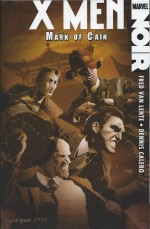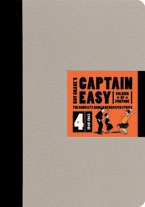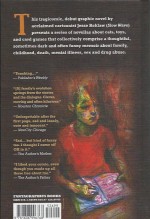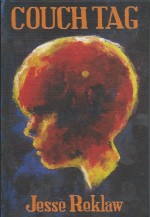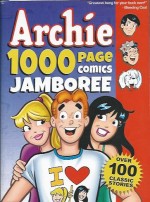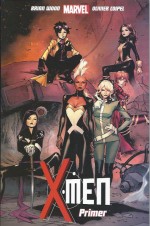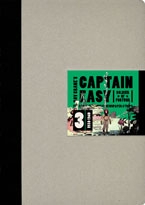
By Roy Crane with Leslie Turner (Fantagraphics Books)
ISBN: 978-1-60699-529-7
The comics industry evolved from newspaper strips and those impossibly successful, circulation-boosting pictorial features were, until relatively recently, utterly ubiquitous, hugely popular with the readers and thus regarded as invaluable by publishers who used them as a powerful sales weapon to guarantee consumer loyalty, increase sales and ensure profits. Many a pen-pushing scribbler became a millionaire thanks to their ability to draw pictures and spin a yarn…
It’s virtually inconceivable for us today to grasp the overwhelming power of the comic strip in America (and the wider world) from the Great Depression to the end of World War II. Before domestic television, with broadcast radio far from universal and movie-shows at best a weekly treat for most folks, entertainment was mostly derived from comic sections of daily and especially Sunday Newspapers. The Funny Pages were a universally shared recreation for millions; who were well-served by an astounding variety of features of spectacular graphic and narrative quality.
From the outset humour was paramount – that’s why they’re called “Funnies†and “Comicsâ€. Soon the gag-&-stunt beginnings – a blend of silent movie slapstick, outrageous movie serial antics, fabulous fantasy and old fashioned vaudeville shtick – evolved into a thoroughly unique entertainment hybrid.
Roy Crane’s Wash Tubbs combined all of the above with sharp witty dialogue and a breathtaking sense of day-to-day progression, in short serial continuity. What lifted him above all his contemporaries – who were making similar advancements in the new art form – was that Crane was blending the comedy with rousing, rollercoaster action and riotous adventure…
Debuting on April 21st 1924, Washington Tubbs II began as a typical gag-a-day strip not entirely dissimilar from confirmed family favourite Harold Teen (produced by Crane’s friend and contemporary Carl Ed). Wash was a diminutive but eagerly ambitious young shop clerk, in search of a fortune and with an eye to the ladies.
Gradually, however, he moved into mock-heroics, then through harm-free action into full-blown – but still light-hearted – rip-roaring and decidedly dangerous hazardous trials, ordeals and exploits. This evolution culminated in the savvy introduction of pioneering he-man, moody swashbuckling prototype Captain Easy in the landmark episode for May 6th 1929.
With his daily continuities increasingly more exotic and thrill-drenched every week, the globe-trotting tiny titan clearly needed a companion who could believably handle the rough stuff, and thus in the middle of a ferocious and crazy European war Tubbs liberated a taciturn and enigmatic fellow American from a jail cell and history was made. Before long the odd couple were inseparable comrades travelling the world: hunting treasure, fighting thugs and rescuing a procession of startlingly attractive damsels in distress…
The bluff, two-fisted, edgily capable and utterly dependable down-on-his-luck “Southern Gen’leman†was something previously unseen in the Funnies: a raw, square-jawed hunk played dead straight rather than the mere buffoon or music hall foil of such classic comics as Hairsbreadth Harry or Desperate Desmond.
Moreover Crane’s seductively simple blend of comic exuberance and compelling semi-serious “bigfoot†cartooning was a far more accessible and powerful medium for action story-telling than the gorgeous yet static illustrative tableaux style favoured by artists like Hal Foster (who was just starting to draw attention on the new Tarzan Sunday page).
Tubbs & Easy were every bit as exotic and thrilling as the Ape Man but calamitously rattled along like the tumultuous, tempestuous fantastical Popeye: full of vim, vigour and vinegar.
The overall effect was electrifying – as attested to by a close look at the early works of the young cartoonists who followed the strip with avid intensity: Floyd Gottfredson, Milton Caniff, Jack Kirby, Will Eisner and especially an impressionably admiring Joe Shuster…
After a couple of abortive attempts starring his little hero, Crane eventually bowed to the inevitable and created a long-awaited full colour Sunday page dedicated to his increasingly popular vagabond paladin. Captain Easy debuted on July 30th 1933, in madcap, two-fisted exploits (originally) set prior to his fateful meeting with Tubbs but eventually coalescing with the Monday to Saturday feature.
The third terrific tome in this stupendous 4-volume set covers May 22nd 1938 to December 15th 1940 and opens with a Foreword by Rick Norwood which contrasts the storylines in Daily and Sunday iterations whilst re-presenting a number of artist Crane’s illustrated articles on life in Mexico, after which R.C. Harvey’s Introduction provides some historical context and speculates on a potential real-life inspiration for the enigmatic Captain.
There’s also a long-overdue appreciation of the artist’s friend, silent partner and eventual successor in ‘Easy Does it…And So does Leslie Turner’. Turner, at first hired to provide Crane some time and breathing room from the punishing seven day a week deadlines, increasingly took responsibility for the Sunday strip from 1937 when the Newspaper Enterprise Association syndicate ordered Crane to drop his beloved experimental full-page designs.
When he first began the Sunday page in 1933 Crane’s creativity went into overdrive: an entire page and sharp vibrant colours to play with had clearly stirred his imagination. The results were wild visual concoctions which achieved a timeless immediacy and made each instalment a unified piece of sequential art. The effect of the pages can be seen in so many comic and strips since – even in the works of such near-contemporaries as Hergé and giants-in-waiting like Charles Schulz.
The pages were a clearly as much of joy to create as to read but the commercial argument ran that the company couldn’t sell a feature which client periodicals were unable to cut-up and reformat to suit their own needs…
In 1943 the former assistant subsequently inherited the black-&-white Dailies after Crane quit NEA to produce his creator-owned Buz Sawyer strip for William Randolph Hearst’s King Features syndicate.
Once Crane was gone, Turner took Wash and Easy into ever more comedic regions, crafting the strip until his retirement in 1969 after which other writers and artists carried the Captain until the feature was ended in 1988.
But that’s largely immaterial as here the superb high-adventuring is seen in its absolute prime…
As seen in Roy Crane’s Captain Easy, Soldier of Fortune: The Complete Sunday Newspaper Strips volume 2, after a spectacular string of solo adventures the solitary soldier of fortune at last met Tubbs whilst stuck in a jail cell in a Ruritanian European kingdom. He had been framed in an espionage plot…
Risking life and diminutive limb to save his pal, Wash also rescued sultry spitfire Ruby Dallas who promptly entangled them in her own unfortunate tale of woe. Witness to a murder in America, she had been on the run ever since because the killer was a prominent millionaire with too much to lose…
Once the trio had escaped murderous cutthroats, slavers and assassins they soon settled his hash and the story picks up here with the boys again looking for a job and passage home. Opportunity knocks in the form of an animal collector in need of a crew, but when his tiger gets loose on the boat everybody jumps overboard.
The lads wash up on the isolated island of Koolyhow where an American entomologist and his female assistant are hunting the legendary doodle-bug. Signing on as helpers they become embroiled in the burgeoning madness gripping local governor Sergeant Major Gaspe Shalayli, and further complicating matters is a lost temple full of ancient treasures and a cute furry creature called a Swink.
The gluttonous little ant-eater has taken a shine to Wash and has a capacity for finding trouble or creating chaos exponentially greater than his new owner’s…
With bugs and Swink – christened “Bennie†– the triumphant Americans reach Singapore only to be targeted by grifters Sadie and Dipper who believe their latest marks have kept the temple jewels (actually confiscated by the local government). Tricking their way onto the flying boat carrying Wash and Easy home, they cause a crash which leaves Sadie and our heroes stranded on a desolate island inhabited by the extremely civilised descendents of piratical bandits.
The place is a utopian paradise with only one rule: nobody ever leaves…
Of course Easy, Wash and Bennie do: in a stolen sail boat which promptly starts sinking, leaving the voyagers in dire straits. They’re almost saved by a passing vessel but the pirates aboard the Typhoon gleefully ignore their plight and sail on…
Frantically bailing, they reach land just as Cap’n Robbins sinks and plunders a trading ship. Again in hot water, Wash and Easy rescue Mona Milson – stranded survivor of a previous shipwrecking – and return her to her grateful father on yet another Pacific paradise, only to find the furious Robbins waiting for them.
He’s just agreed to transport the old gent, his family and, most importantly, his life savings to Honolulu…
Unable to dissuade old man Milson, the boys book passage with him and Mona and, after days of outrageous hijinks as the voracious and disaster-prone Bennie makes life hell for the pirates, expose and capture the villains.
With reward money in their pockets Wash and Easy (and the Swink) finally get back to America and begin a search for gainful employment which highlights a return to gag-filled short stories.
The ever-hungry Swink is a popular sensation, prompting his owners to buy a travelling medicine show truck, and whilst touring the country they discover that the elixir they’re peddling has genuine restorative powers as they encounter a succession of conmen, women, thieves, scheming women, bandits and determinedly marriage-minded women – some of whom even steal the fabulous, potentially valuable Bennie. A Martyr to crazy, hungry critters Wash improbably inherits a hippo named Kittie.
It’s just one disaster after another…
Feeling they’ve outlived their welcome Wash and Easy decide to go adventuring again, accidentally ending up in Peru, where dauntless Mary Lancaster is searching for her lost father. She enlists their help to enter the forbidden Lost Canyon region where they discover not only the missing archaeologist but a lost race of Indians who still practise human sacrifice…
The humans only escape by trading their lives for Bennie, but as they make their forlorn way back to civilisation the indomitable Swink catches up to them, having proved too smart for the Andean natives…
Packing the Lancasters off home, but too short of funds to accompany them, our heroes are soon clapped in jail for vagrancy where they meet magician, ventriloquist and escapologist “the Great Plunkettâ€: an inveterate prankster who joins them as stowaways on a steamer back to the USA.
Once there, Plunkett’s gift for opening safes makes him a target for opportunistic mobsters – until his new friends step in…
Big changes were underway at this time and Turner was increasingly yielding the focus on his titular stars to explore an array of new and returning supporting characters – presumably to allow Crane more leeway, if not exclusivity – on Tubbs and Easy. However with the instalment for 21st January 1940, the boys were back, as Easy became a freelance spy-hunter and crimebuster in a nation progressively, inevitably marching towards war. The tone was still light and humorous, but the writing was on the wall…
After stopping spies he tracked down escaped convict Killer Beck, exposed the murder of a Chinese servant and captured America’s Most Wanted female-impersonating conman.
That led to his being hired to safeguard a new aviation weapon from a veritable army of foreign agents and the diabolical Mata Hari Z-1.
Defeating her led to Easy and Wash being marooned in a vast jungle of cactus in the Western American desert where they stumbled onto a gang of ruthless counterfeiters before tackling train-stealing gunrunners in Mexico.
More short yarns bracket a concerted re-lightening of mood as the lads are hired by arrogant, flighty heiress Honey Darling – who wants to be a movie star – and uses them to stage dangerous, headline-grabbing stunts, before the boys are hired to recover a yacht and rescue the passengers after he Captain loses control of it in a rigged card game…
The mission goes slightly awry and leaves the boys, heiress Ginger Nelson, her chaperone aunt and some of the more nefarious crew members shipwrecked. Amongst the saved luggage is the 12th biggest diamond in the world.
…And then the murders start happening…
Nevertheless Easy and Tubbs save the day again, but when they return stateside the surly Soldier of Fortune is made the basis of a bet between two wealthy men. One is wagering that any man can be made afraid and the other believes Easy disproves the notion.
Of course neither has asked him to participate, and after the hero is tricked into a haunted house the trouble really begins as the mountaintop dwelling is invaded by bandits wanting their perfect hideout back…
After discovering the only thing that frightens Easy, this compelling cartoon carnival ends with the heartwarming tale of newsboy Buddie Burns who turns his passion for detecting into a successful anti-crime campaign… with a little help from a certain Southern Gen’leman…
Also included are many examples of original artwork and this colossal luxury hardback compilation (pages 380 x 270mm) even includes an extra colour tear-sheet plus a full hand-coloured page by Crane, used as a guide by the print processors to produce the final flat-hued instalments
This volume heralds the irrepressible humour which Turner would increasing bring into the feature and the stories – although still action adventures – abound with breezy, light-hearted banter, outrageous situations, hilarious slapstick and outright farce – a sure-fire formula modern cinema directors still plunder to this day.
Captain Easy was the grandfather of Indiana Jones, Flynn (the Librarian) Carsen and Jack (Romancing the Stone) Cotton and clearly set the benchmark for all of them. Happily Crane’s rip-snorting, pulse-pounding, exotically racy adventure trailblazer fell into hands every bit as talented and the huge pages in this stupendous chronicle, crackling with fun and excitement, provide the perfect stage from which to absorb and enjoy the classic tale-telling of another sublime master raconteur.
This is storytelling of impeccable quality: unforgettable, spectacular and utterly irresistible. These tales rank alongside the best of Hergé, Tezuka, Toth and Kirby and unarguably fed the imaginations of them all as they still should for today’s comics creators. Now that you have the chance to experience the strips that inspired the giants of our art form, how can you possibly resist?
Captain Easy strips © 2012 United Feature Syndicate, Inc. This edition © 2012 Fantagraphics Books, all other material © the respective copyright holders. All rights reserved.
